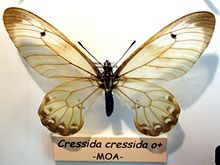- Cressida cressida
-
Cressida cressida 
male 
female Scientific classification Kingdom: Animalia Phylum: Arthropoda Class: Insecta Order: Lepidoptera Family: Papilionidae Genus: Cressida Species: C. cressida Binomial name Cressida cressida
(Fabricius, 1775)Synonyms Papilio cressida Fabricius, 1775
The Clearwing Swallowtail or Big Greasy, Cressida cressida, is a medium-sized swallowtail butterfly (family Papilionidae) found in Australia, Papua New Guinea and Indonesia. It is not a threatened species.
Contents
Description
The adults are dissimilar in appearance. Males have translucent forewings with two black spots and a fine black border thickest at the apex of the wing. The hindwing has a thick black border surrounding a central white area with black veining. The black border encloses a series of red spots, whose size and number can vary. Females have wings that are a semi-translucent tawny colour, similar to aged greaseproof paper. This colouration is most intense immediately after the butterfly emerges, but soon fades and renders the wing almost totally transparent. Patterning of the female wing is similar to that of the male, but greatly reduced and diffused, with white areas on the hindwing extremely reduced and all red markings replaced by pale pink. Both sexes have a black body heavily marked with red scales.
Ecology
The larvae feed on Aristolochia species, including A. tagala in the tropics. More usually, it utilises smaller growing species such as A. thozetii and Eucalyptus forest where its hosts grow as small scrambling vines in open areas. It is most common in forests bordering the Great Dividing Range.[2]
Mating
Cressida cressida is unique in having modified the spermatophore into an external mating plug known as a sphragis (plural sphragides). The sphragis acts to increase the chance of individual males successfully producing offspring by preventing other males from inseminating already mated females. There is evidence that females have attempted to counter this strategy by evolving remarkably broad genitalia that makes it more difficult for sphragides to remain in place. The evolutionary incentive to counter the sphragis is likely the nutritional benefit females obtain from the spermataphore, hence multiple matings provide female butterflies with additional resources. Orr provides an excellent summary of the evolutonary dynamic between males and females of C. cressida.[3]
References
- ^ Australian Plant Census (2010). "Aristolochiaceae" (PDF). http://www.chah.gov.au/chah/apc/interim/Aristolochiaceae.pdf. Retrieved 6 March 2010.
- ^ Michael F. Braby (2000). Butterflies of Australia: their Identification, Biology and Distribution. Melbourne: CSIRO Publishing. ISBN 9780643065918.
- ^ A. G. Orr (1999). "The Big Greasy, Cressida cressida (Papilionidae)". In R. L. Kitching, E. Scheermeyer, R. E. Jones & N. E. Pierce. Biology of Australian Butterflies. Monographs on Australian Lepidoptera. 6. Melbourne: CSIRO Publishing. pp. 115–134. ISBN 9780643050273. http://books.google.com/books?id=cTFychx78QIC&pg=PA115.
Categories:- Lepidoptera of Australia
- Papilionidae
- Animals described in 1775
Wikimedia Foundation. 2010.
